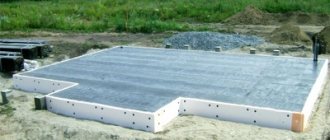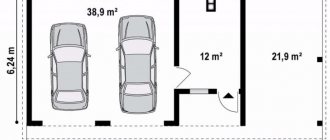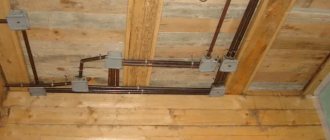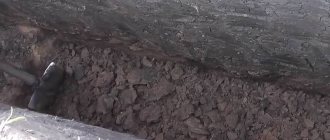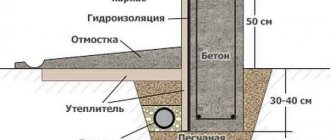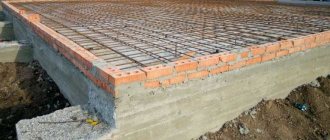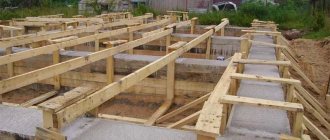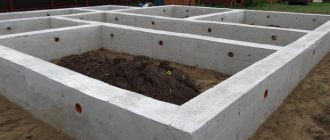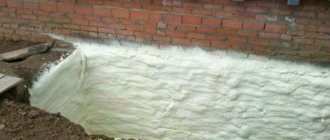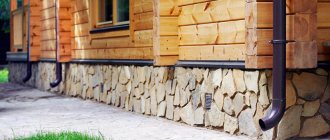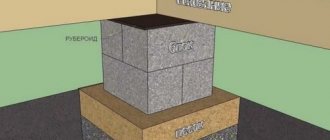The construction of a private house, garage, barn or other structures begins with preparing and pouring the foundation. This stage requires careful preparation, selection of high-quality cement and sand. Otherwise, pouring the foundation for the house may not give the desired result.
Therefore, before starting work, it is necessary to consider how to properly pour the foundation for a house, the main stages of the work and the choice of the optimal type of structure for various buildings.
Information about the soil and nearby buildings
Starting to do something without prior preparation is simply unwise. The beginning of all beginnings in construction is the preparation of project documentation; and designing a house and foundation, in turn, can only be done based on the results of a geological examination of the site, which will reveal the individual characteristics of the soil and take into account the relief.
The lowest freezing point of the soil in winter will allow you to determine the type of foundation and its depth. It is better to entrust a detailed analysis of the soil and the choice of foundation type to qualified specialists.
Landscape design will help you choose the most convenient location of the house, auxiliary buildings, paths and gazebos. Modern technologies allow you to see your future home from all angles.
The linear dimensions of the base are only part of the foundation design Source moifundament.ru
Waterproofing
Waterproofing is the procedure of applying a cutting layer to the surface of a concrete strip.
There are two types:
- Horizontal waterproofing. It is performed from below and above the tape and allows you to eliminate the process of capillary absorption of moisture by the concrete tape from the lower soil layers or to cut off the walls from the concrete, preventing the penetration of water. Usually a double layer of roofing material is used, coated with hot bitumen or mastic.
- Vertical waterproofing. This is the process of applying insulator to the side walls of the tape. Various materials are used, roll, liquid or impregnation.
There are opinions that waterproofing is not necessary. Some experts are inclined to believe that moisture does not pose a serious danger to concrete. However, in regions with severe frosts, wet concrete can be destroyed by water expanding during freezing, so waterproofing should be taken as responsibly as possible.
Preparatory work
The preparatory work stage occupies an important place in the process of building a house. First of all, it is necessary to clear the area of construction debris, cut down excess trees and uproot stumps, and remove dry grass.
Preliminary zoning of the site will allow you to effectively use every corner during operation. It is best to level the surrounding area before starting construction work and laying the foundation. This will not only give the site an attractive appearance, but will greatly facilitate construction work at all stages. The terrain with large differences requires stepwise leveling of the territory.
Next, the exact location of the house is determined and the foundation is marked. To do this, pegs are installed in all corners of the future building. If the house is a standard rectangular shape, the result should be a figure with perfectly equal angles of 90°. If the angle is not maintained, it is necessary to achieve this result by moving the limit cord in one direction or another.
Along the future walls, at the same distance from each other, pegs are also installed and a rope or cord is pulled between them. The diagonals drawn between the corners of the building must be exactly equal to each other.
An example of checking angles in markings - if the diagonals are equal, then all angles are 90° Source homeframe.ru
When marking for a strip foundation, it is necessary to retreat from the walls of the house at a distance equal to the width of the foundation. Most often this figure is no more than 20 cm.
You can dig a trench either by hand or using specialized equipment. It is formed at least 20 cm below the freezing point of the ground, characteristic of the area in winter. It is necessary to dig a trench strictly following the markings and forming a flat bottom.
Preparing the trench
Preparatory work requires the availability of construction equipment. It is possible to do them manually, but it will require a significant investment of time and labor. In the end, it always turns out to be faster and cheaper to pay for the work of a bulldozer and excavator.
Procedure:
- Removing topsoil and unnecessary vegetation, site planning.
- Marking using wooden pegs. It is recommended to install them outside the perimeter of the future trench, and mark the boundaries and intersections with cords stretched between the stakes. This will allow you to save them and clarify the contours of the trench if doubts arise about the correctness of the actions.
- Digging a trench to a certain depth. The excavated soil is placed on the outside or transported outside the site.
- Backfilling the sand cushion. The classic option is the sequential laying of 20 cm of sand, 20 cm of crushed stone and a leveling sand layer of 5 cm. Each of them is carefully compacted. The immobility of the future tape depends on the density of the pillow. Settlement threatens to destroy the building, so the quality of the compaction should be taken seriously.
- Laying a double layer of waterproofing on top of the pillow. Typically, roofing felt is used, which is laid without gaps or gaps.
Upon completion of these actions, you can proceed to the next stage of work.
NOTE!
Sometimes a layer of the so-called is poured on top of the pillow. footings - about 5 cm of concrete, forming a flat and dense platform. It allows you to keep the waterproofing intact and prevents the pillow from being pressed through by the rods of the armored belt.
Methods for saving a house foundation
One of the exciting questions when building a house is how to lay the foundation for a house cheaply and with high quality. There are several ways to save at least a little:
- Digging the soil and pouring the foundation for a house with a concrete mixture is the most expensive stage in the construction of a country house. Whether to do all the work yourself or entrust it to professionals - everyone decides for themselves.
- Forming a shallow foundation will save a significant amount of money. However, it is only suitable for the construction of low-rise buildings made of lightweight materials. In all other cases, a deep foundation is used, erected below the freezing point of the ground.
- The formwork is assembled from boards, which can later be used as a subfloor or for other work in which the appearance of the material will be of secondary importance.
After the concrete has hardened, the formwork boards are removed and can be reused Source sovet-nso.ru
See also: Catalog of companies that specialize in foundation repair and design.
- When pouring a slab foundation, you can save money by using a thinner base with the formation of stiffeners.
- The possibility of using fiberglass reinforcement instead of steel materials will also allow for minor savings.
Reinforcement
The placement of reinforcement is necessary to increase the structure's ability to resist bending loads. Reinforcement of strip and column bases is performed with spatial frames. Meshes are used for the slab. If the structure thickness is more than 150 mm, the mesh is laid in two layers. The following are the main recommendations for reinforcement:
- calculations for a private house can be performed in a simplified form, assigning the total area of the rods depending on the cross-section of the structure; the minimum diameters differ for different types and sizes of foundation, so this issue requires separate consideration;
- for the manufacture of frames and meshes, reinforcement of a strength class not lower than A400 can be used, but the use of rods A500 and higher is not economically justified;
- it is important to observe the protective layers of concrete; in general, it is worth remembering the following numbers: foundations without concrete preparation - 70 mm, with concrete preparation - 40 mm;
- reinforcement should be provided in the corners; usually the pitch of transverse horizontal and vertical reinforcement is halved, and the main reinforcement is also reinforced with U or L shaped clamps.
Read more in the article: How to reinforce a strip foundation.
Features of pouring a slab foundation
Slab foundations are most often used in the construction of brick, frame and stone country houses. In this case, the slab is located not only under the load-bearing walls of the house, but also under the entire structure and requires the formation of a perfectly flat surface.
To fill a slab foundation, a sand cushion up to 30 cm high is poured, reinforced concrete slabs are laid, a reinforcing frame is formed and a concrete screed is made.
It is the most expensive, but it fully ensures the strength and reliability of the foundation during the operation of the facility.
The slab foundation has a rather complex structure Source profundamenti.ru
Drainage
This element is necessary to remove excess moisture from the supporting part of the house. It is carried out even when the groundwater level is low to prevent troubles when liquid rises in the spring or during large amounts of precipitation. Work on laying drainage pipes must be carried out in accordance with the following recommendations:
- depth relative to the base of the foundation by 30-50 cm;
- the distance from the foundation of the house is no more than 1 m;
- the slope of the pipes in one direction is assumed to be 3-4 degrees so that the liquid moves by gravity;
- To prevent silting, the crushed stone laid around the pipes is wrapped in a layer of geotextile with an overlap of 30 cm.
We recommend: Draining water from the foundation of the house.
Features of pouring a columnar foundation
A column foundation is often confused with a pile foundation, but in fact these are two completely different technologies. If the piles are necessarily screwed in below the freezing depth of the soil, then the columnar pile is a hole, about 50-70 cm deep, the bottom of which is covered with sand, and concrete is poured on top, mixed with some stones.
On a note! A columnar foundation is not suitable for a residential building, since it is designed for ultra-light buildings - small bathhouses without a stone stove, gazebos, sheds and similar outbuildings.
A columnar foundation does not require additional waterproofing work, but, like a pile foundation, it excludes the possibility of arranging a cellar or basement. Since it is laid at a shallow depth, it is mainly used on sandy soils and sandy loams, which are indifferent to heaving and natural soil movement.
To pour a columnar foundation, concrete blocks are used, fastened together with reinforcement and filled with ready-made concrete mixture. Any material is suitable for forming concrete blocks:
- brick;
- stones;
- basalt;
- cobblestones;
- ready-made reinforced concrete blocks.
Columnar foundation - a shallow budgetary foundation for outbuildings Source stopdacha.ru
Columns are installed in all corners, as well as at intersections of walls and points with increased load at a distance of no more than 2 meters from each other. In this case, formwork is formed, pillars are installed and pulled together with reinforcing material. The entire structure is filled with a mixture of concrete.
Reviews
Before starting construction of the house, I considered different options for foundations - I really didn’t want to incur large expenses, so the strip foundation was not taken into account at all. But in the end I built just like this and I don’t regret it, although I had to tinker with it, since I did everything myself. But now I have a large basement under the house, an underground garage and absolutely dry, thanks to waterproofing. And if I decided to save money, I would lose so much usable space. Peter, Uvarovo
We bought the plot on clay soils, so at first they wanted to put the house on a pile or columnar foundation, but wise people recommended a buried strip foundation. We did just that and have not regretted it for six years now - there are no cracks in either the house or the foundation. Anatoly, Rossosh
I agree that a strip foundation is reliable and will last for centuries, but in winter our ground freezes to 1 m 90 cm - which means we need a foundation with a height of at least 2.10 m. And this is very expensive, so for my house I am now choosing between a pile-screw and slab Alexey, Murmansk
White sand-lime brick: price per piece, sizes and types of bricks. This article will tell you which interior doors are best to choose.
In this article you can find out reviews about PVC interior doors.
Video description
To see all the work involved in preparing the site and pouring the foundation, watch the video:
Formwork
Before pouring the foundation for the house, it is necessary to form a strong, reliable formwork. To form removable formwork you can use:
- wood;
- metal;
- plywood;
- plastic.
Permanent formwork becomes part of the structure and avoids the dismantling stage. To form it use:
- expanded polystyrene;
- wood boards;
- fiberboard
Permanent formwork block for strip foundation Source ofacade.ru
Recommendations for laying reinforcement
To give strength to the foundation, reinforcement is laid inside it in the form of a grid. A reinforcing rod with a cross section of 8-12 mm is used. It is cut into sections equal to the length of the foundation sections where it will be used.
Vertical rods are installed at regular intervals. Cut reinforcement is tied to them using wire. The result should be a network with cells measuring 3000 mm.
The resulting frame should not come into contact with the ground. To do this, use small supports made from broken bricks or stones, which are placed under the mesh.
Pouring the foundation
Preparing a high-quality concrete mixture and pouring the foundation is an important stage in the construction work of a country house.
sand cushion
A sand cushion is a necessary element in the construction of any structure. To form it, the bottom of the trench is covered with river sand to a height of at least 20 cm. Each layer of sand is thoroughly spilled with water and compacted.
Formwork
To reinforce the foundation, reinforcement and reinforcing rods of various diameters are used. It is better to use thicker reinforcement along the trench. Reinforcing elements can be connected using soft wire.
Work progress
If you purchase concrete from a factory, you won’t have to think about how to pour the foundation for a country house. The automixer will evenly mix the concrete mixture to a uniform, plastic consistency and unload the finished concrete directly onto the site prepared for the foundation.
The automixer will not only bring concrete to the construction site, but will also pour it directly into the foundation formwork Source beton-house.com
Work begins from the corners of the foundation, trying to tightly fill all the voids. The concrete is evenly distributed around the entire perimeter using a shovel, excess air and bubbles are removed.
The finished foundation is wrapped in film and the surface is periodically moistened. This will help prevent the formation of numerous cracks during drying.
How to pour concrete with your own hands
If cement mortar will be purchased from specialized companies producing building materials, then the first thing you need to pay attention to is the brand of the product. M-200, M-250 are considered high-quality compositions. It is these types of building compositions that are ideal for the construction of small-sized premises.
These brands are characterized by a fast thickening rate. Regular mixing of its components or the presence of a small concrete mixer will help prevent the solution from drying out.
We carefully distribute the finished composition over the area of the entire formwork. When distributing the solution, it is necessary to take into account the presence of air gaps. Experienced professionals do not recommend carrying out construction work during rainfall.
Large construction companies most often fill the foundation in the autumn or winter. To prevent the building composition from coming into contact with high humidity and seasonal precipitation, additional shelters are used.
